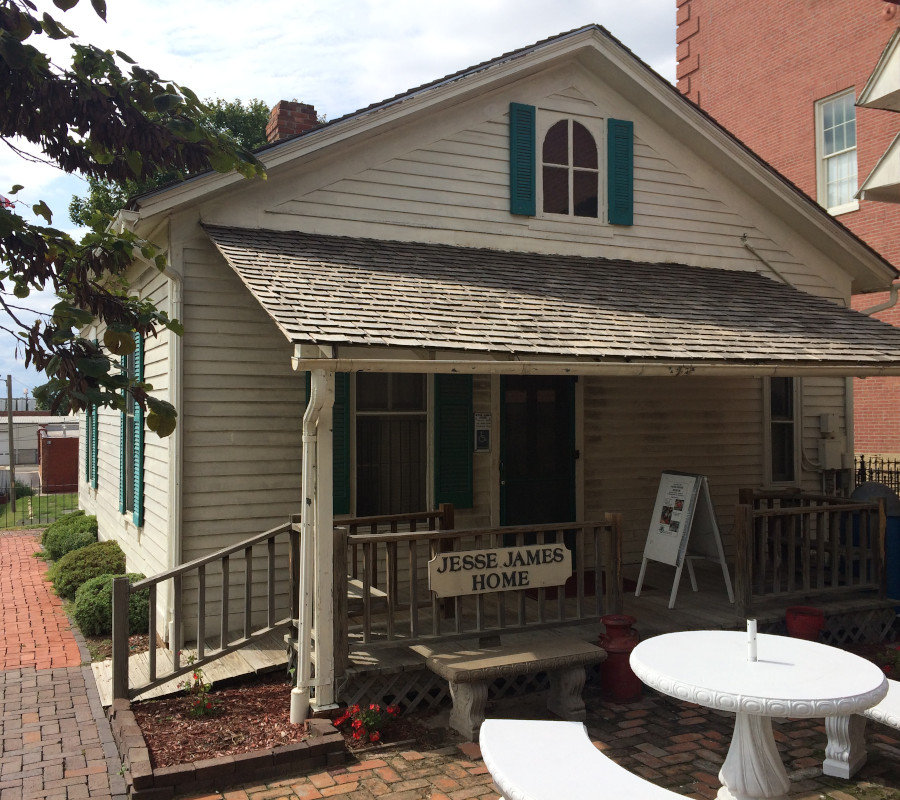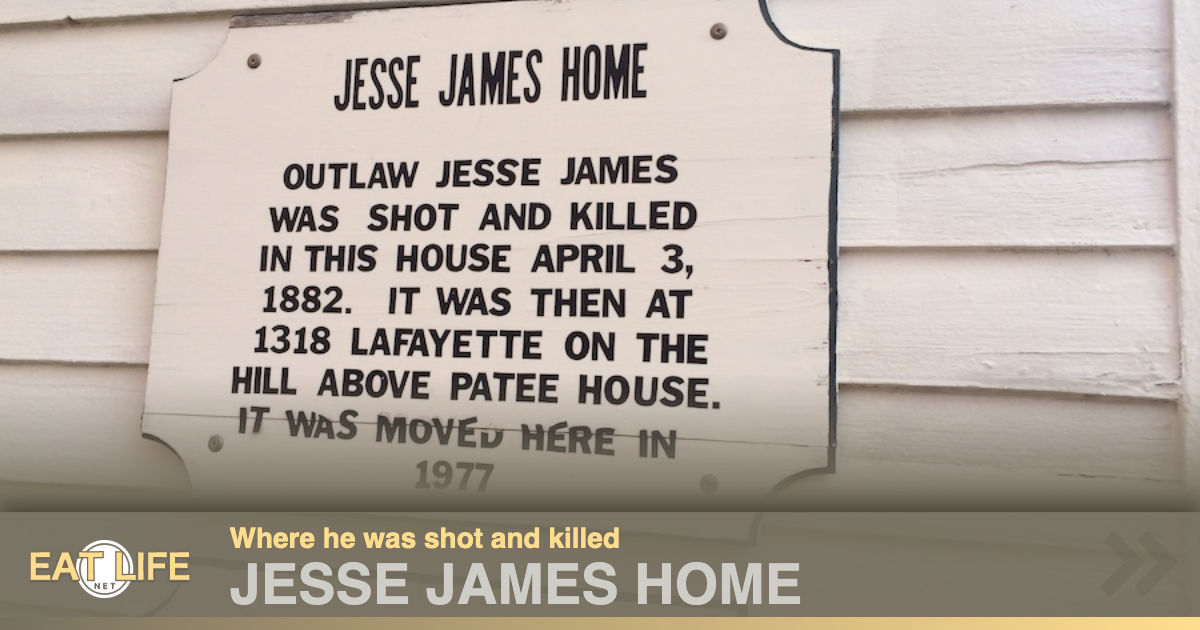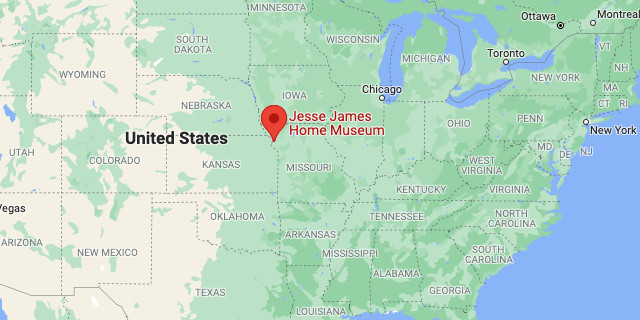
https://www.google.com/maps/place/Jesse+James+Home+Museum
The end of Jesse James:
Notorious outlaw Jesse James was shot and killed in this house on April 3, 1882. He was killed by Bob Ford, a member of the James gang, to collect a $10,000 reward offered by Governor Tom Crittenden.Jesse died at the age of 34 after living a lawless career for 16 years. He was living with his wife and two children under the assumed name of Tom Howard at the time of his death.
Jesse was shot from behind while he stood on a chair to straighten a picture in his own home.
After the shooting, Jesse's wife and two children and his mother, Mrs. Zerelda Samuel, spent the next two nights at Patee House, which was then called the World's Hotel.
In 1995 forensic scientist James Starrs exhumed the outlaw's body at Kearney, Missouri, for DNA tests. The results showed a 99.7% certainty that it was Jesse James who was killed here in 1882. Artifacts from the grave are now on display including:
- The coffin handles
- A small tie pin Jesse James was wearing the day he was killed
- A bullet removed from his right lung area
- A casting of his skull, showing the bullet hole behind his right ear
The James Home was originally located about two blocks north of its present location, at 1318 Lafayette Street, on a high hill overlooking Patee House. In 1939 it was moved to the Belt Highway in St. Joseph as a tourist attraction. Mr. and Mrs. Robert Keatley purchased the James Home in 1977 and donated it to the Pony Express Historical Association. The house was moved back to its original neighborhood and today it is located on the grounds of Patee House Museum.
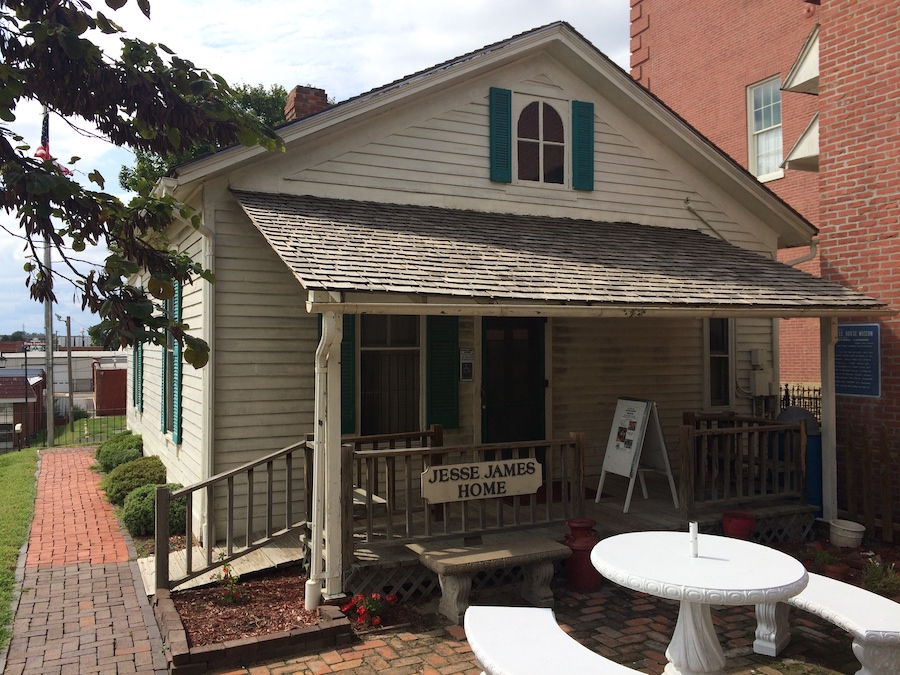
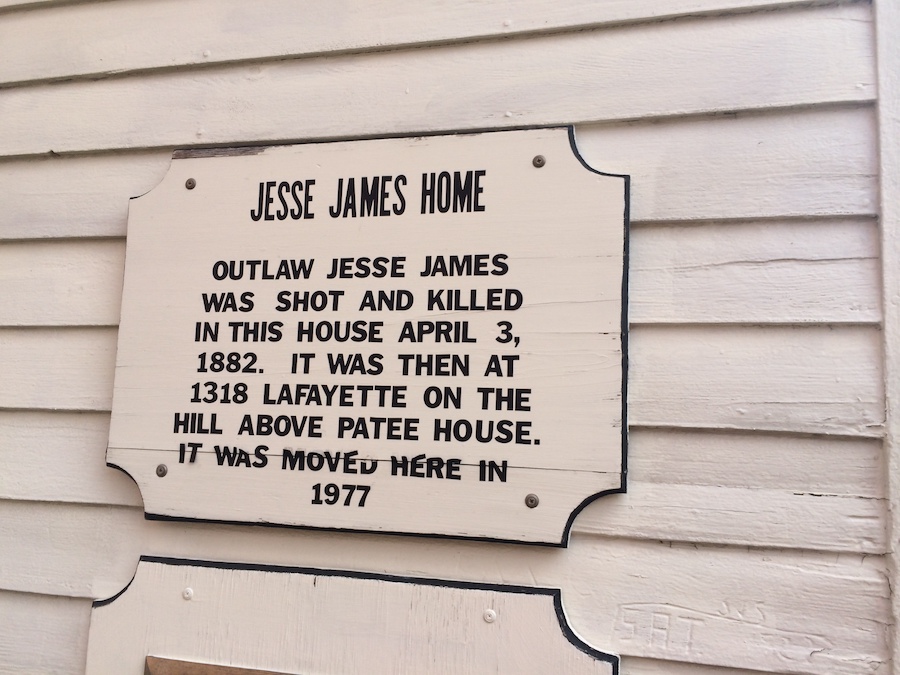
Outlaw Jesse James was shot and killed in this house April 3, 1882. It was then at 1318 Lafayette on the hill above Patee House. It was moved here in 1977.
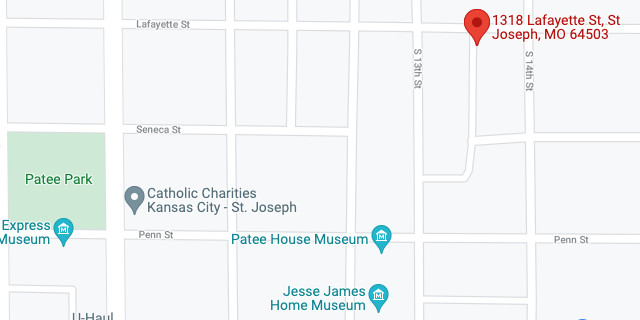
Original Location of the Jesse James House was two blocks away
https://www.google.com/maps/place/1318+Lafayette+St,+St+Joseph,+MO+64503
About Jesse James:
He was one of the most notorious outlaws of the 19th Century. Also known as Jesse Woodson James, was born on September 5, 1847 to Reverand Robert James and Zeralda Cole. At an early age, James accompanied his brother Frank to fight for the rebel cause and joined a band of guerilla fighters established by William Quantrill. He learned a lot about guerrilla activities during the Civil War, and after the war he formed a gang of outlaws. On April 3,1882, Jesse James was gunned down by a fellow gang member, Robert Ford, at his house in St. Joseph.
This simple Missouri home went down in American history when the infamous Wild West bank robber Jesse James was gunned down inside. Today, it holds a museum to James' life and death inside, complete with a bullet hole in the wall that dates back to the shooting.After a life full of criminal activity that made Jesse James famous in his own time, the outlaw eventually attempted to settle down (at least for a while) with his family in St. Joseph, Missouri.
Despite being feared and renowned as maybe the most prolific criminal in American history to that point, James was also noted as a husband and father who took great care of his familyUnfortunately, by the time they settled in their Missouri home it was too late for any kind of peace. The $10,000 reward for James' capture was just too sweet a pot for his accomplices to ignore. Finally, on April 3, 1882, one of James' former partners in crime, Robert Ford, put a bullet in the back of James' head right in his own home.
When the disreputable Ford brought in James' body to collect the reward, the authorities actually arrested him for murder. Ford would go on to die in a bar fight a few years later, remembered by few, loved by none.James, however, is still an American icon, and the former home where he was shot has become a museum to his legacy.
In 1995, top forensic scientist Professor James E. Starrs, of George Washington University, conducted an exhumation of the grave of Jesse James to settle persistent controversy about the remains. In February 1996, he announced that DNA tests performed on the remains and compared to the DNA of existing known relatives proved a 99.7% reliability that the body in the grave was that of Jesse James.
The Jesse James Home Museum is the house in St. Joseph, Missouri where outlaw Jesse James was living and was gunned down on April 3, 1882, by Robert Ford.Jesse James Home Museum:
- It is a one-story, Greek Revival style frame dwelling measuring 24 feet, 2 inches, wide and 30 feet, 4 inches, deep
- At the time, the house was located at 1318 Lafayette Street in St. Joseph
- In 1939, it was moved to a busier Belt Highway location
- In 1977, it was moved to a location directly behind Patee House at 12th and Mitchell in St. Joseph, only two blocks away from its original location, which restored more of its historic context
- The house has a large bullet hole on the north interior wall. The hole was actually much smaller but over the years, souvenir hunters carved shavings from the hole and enlarged it
- The Jesse James Home contains a number of items owned by Jesse James and his family
The investigation into the shooting death of James was conducted at Patee House Hotel (formerly the World's Hotel). Mrs. James, her two children, and Jesse's mother stayed in Patee House for two nights after Jesse James was killed.The museum includes new exhibits based on the 1995 exhumation including:
The home was listed on the National Register of Historic Places on September 4, 1980.
- Artifacts such as coffin handles
- Bits of wood
- A pin Jesse James wore in his death photo
- Numerous photos taken during the exhumation
Jesse James was a bank and train robber in the American Old West, best known as the leading member of the James-Younger gang of outlawsJesse James:
Jesse James and his brother Frank served for the Confederate Army before embarking on criminal careers in the Old West. The James brothers made a name for themselves as bank and train robbers, leading the James-Younger gang. Gang member Robert Ford killed Jesse James in 1882, after which James became a legend of the Old West.
Early Life:
American outlaw, robber and legendary figure Jesse Woodson James was born on September 5, 1847, in Kearney, Missouri.
Jesse and his brother Frank James were educated and hailed from a prestigious family of farmers. Their father, the Reverend Robert James, was a Baptist minister who married Zerelda Cole James and moved from Kentucky to Missouri in 1842. In the summer of 1863, the James farm was brutally attacked by Union soldiers.
Jesse was 16 when he and Frank became Confederate guerrilla soldiers, riding alongside William Quantrill and "Bloody Bill" Anderson.
Partners in Crime:
Some historians accuse Jesse and Frank of being cruel to Union soldiers, while others argue that it was the brutal treatment the brothers received that turned them to a life of crime.
Either way, they rebelled against harsh postwar civil legislation and took the law into their own hands.
They began robbing trains, stagecoaches and banks that were owned or operated by a Northern institution.
There has been speculation that the boys and their gangs were like Robin Hood, robbing the rich and giving to the poor, but there is no evidence for that. Most likely, they kept the money for themselves. From 1860 to 1882, the James Gang was the most feared band of outlaws in American history, responsible for more than 20 bank and train robberies and the murders of countless individuals who stood in their way. They stole an estimated $200,000. They were legends in their own time, popular in Missouri for actively trying to further the Confederate cause.
On December 7, 1869, the gang robbed the Gallatin, Missouri, bank. Jesse asked to change a $100 bill, and thinking that the banker was responsible for the death of Bloody Bill, shot the man in the heart. Local newspapers labeled the actions vicious and bloodthirsty and called for the gang's capture. From that robbery to the end of their careers, members of the James Gang had a price on their heads, dead or alive.
Death:
After breakfast on April 3, 1882, Jesse turned to straighten a picture on a wall of his home, and Bob shot Jesse in the back of the head.
Jesse died instantly at age 34.
People in Missouri were outraged at the method used to capture him and considered it a cowardly assassination.
Within three months, Frank surrendered to Crittenden.
The juries would not convict on the meager evidence, so Frank resumed a quiet life.
